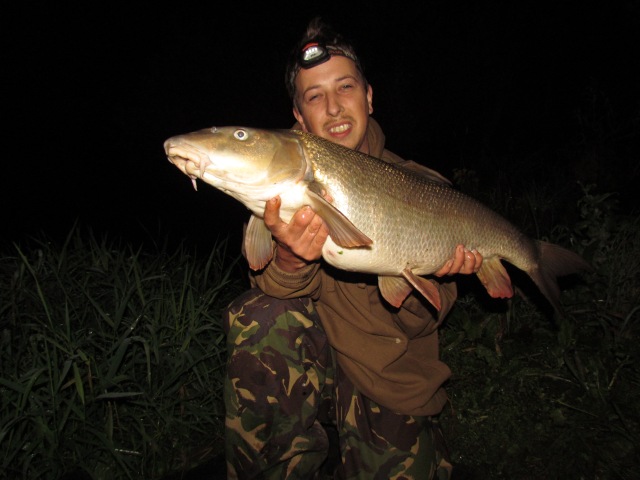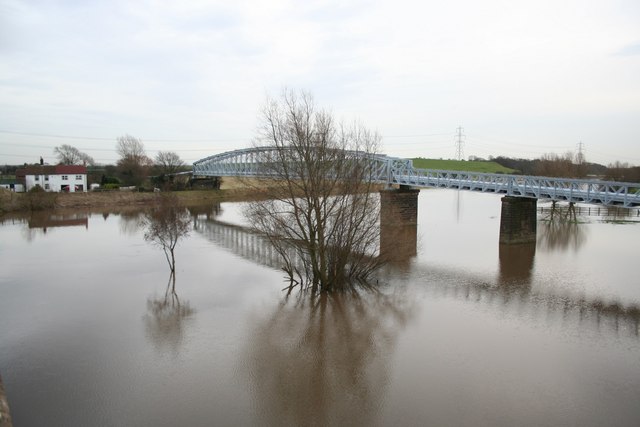As we enter autumn proper you can certainly feel the weather changing, from what was a lovely setting on the banks of the Trent with flowers in full bloom, autumn brings a different kind of loveliness of its own, I guess.
The colder nights and windier days are certainly becoming more apparent and days fishing were somewhat limited also due to this.
I touched upon barometric pressure in the last part and why I think this makes a difference. I hope to give you my take on what to look for when deciding to go barbel fishing. Of course if you listened to everything a weatherman, fishermen and some fan-dangled app on your IPhone told you then you’d probably never make it on the bank at all. I must admit that I pay close attention to rising or falling pressure and I, in this article will tell you why.
Let’s not forget the reason I am writing these articles, ultimately to explain my approach to landing specimens which will hopefully end with a big Trent Sixteen. This is not to say you don’t have your own ideas of how to go about catching these fantastic fish – there’s no right or wrong way to do it, this is just my way.
I am not naive enough to believe everyone who reads my posts hangs on to every word I say, goes out and buys everything I use and god forbid buys my fishing attire, nor would I expect that. We all have our own styles and techniques to catching barbel and so long as you do then there’s no reason to change what you’re already happy with.
I hope to write these articles to snippet my fishing, my techniques, my ideas and my methods to catching them and if you gain something from that then I am happy for that to be the case.
Back on topic – I approach autumn differently to that of summer and lean more towards a winter approach, the elements do determine this factor in my fishing especially during colder spells and tactics should reflect that in my opinion.
For example, I wouldn’t be ‘gung-ho’ in my approach on a river where the temperatures are low and the trend of temperatures are falling, whilst this is not considered a good time to go barbel fishing, with a little finesse in tactics it is still possible to catch with a little or no feed approach.
Tactics
With Autumn firmly set the tactics are refined and feed is kept to a minimum. Temperatures in early autumn will generally hold well, especially on big rivers such as the Trent. Once we approach the middle of autumn however, the colder temperatures on any large river become much colder. Smaller rivers will increase/decrease much quicker in temperature. I am a firm believer in ‘less is more’ approach during these colder months and during the next part I will show you how I get around the baiting approach by attracting the barbel to my boilie hook bait and not actually feeding them anything.
For now however I am still using a feeder but with less actual food content, relying heavily on attractant (powdered crumb) as the source to my boilie approach once again. The feeder will contain a halibut groundbait with one boilie in the middle of this, ensuring that the barbel have very little option to pick-up my hook bait if they wish to. I am also leaving my rods out for longer, giving the barbel more chance to find the source of my feeder contents. Barbel during the colder water temperatures will work less, take their time and not be so ravenous in their approach to find food. This is particularly important to know when stock is generally low and the competition is far less then what it is in other areas of the Trent.
In summer I will keep the bait out for 20 minutes maximum at any one time, during autumn an hour and into winter 1hr 30 mins. I try to stick to these principles, sometimes even setting my alarm clock.
With this approach it pays to remember that in summer barbel are actively searching for food and will travel 100’s of yards to find it. Whereas in winter they will travel less the majority of time and only actively search for food in shorter windows, giving you the angler, a lot less time to catch them.
I am sticking with the same rig as I used in Part 5.
Conditions
Well, unfortunately conditions have deteriorated somewhat from what we have been spoiled with during July particularly. The blue skies have decided to give way to clouds and rain with a brisk wind, making fishing tricky at the best of times with flooded rivers up and down the country. Like I have said earlier I believe barometric pressure is important at any time, when pressure in winter is falling it usually means rain and generally much milder temperatures, in-turn higher pressure (1005 and above) means generally settled and fine weather, with much colder nights, resulting in colder rivers.
I like the pressure to be 995 to 1012 for barbel fishing and have caught more fish during this time than any other.
I am not a expert but I do know that barbel respond better to a falling barometric pressure than a rising one. What you don’t want is a cold north-easterly when the pressure is falling as this will put the barbel right off the feed.
The floods will make things difficult, unless that extra water is warm but as it is coming from the North-East I feel it will have an adverse effect on the barbel and make them very lethargic. It is also worth noting that this cold rain will speed up the cooling down of the river, much like putting a cold tap on in a bath to cool the hot water (if you do it like that).
The Bait
I am sticking with the Dubby and a new boilie that’s under test called ‘The Plum’, which I hope will be a major success as a fantastic all-round bait for many species, including barbel. I am also relying on the groundbait which is dampened heavily, and tightly packed which will take its time to disperse in the feeder once it hits the bottom. This will send the scent trails out slowly, as oppose to a big ‘plume’ all in one go. The idea behind this is simple, barbel whilst can feed avidly during milder spells at this time of the year, their metabolisms will predominately slow down with the water temperatures. I have found that with the help of a thermometer, the water becoming steadily colder over the last weeks or so. So with that my approach is to let signals of attraction out of the feeder with a food item and give it 45 mins, if nothing re-cast and repeat.
I think I speak for most, if not all barbel anglers that the key is finding them, however sometimes all you can do is a pick a spot that you think is consistent and the rest usually follows. Yes you can expect to blank at this time of the year but being in a peg where you know you stand the best opportunity is half the battle.
Nomadic barbel are not found in one spot exclusively – the fish here on the Trent tend to patrol up and down the stretch and it can sometimes be more luck than judgement on whether you get a bite or not. The fish do not give themselves away easily nor can you see them so when faced with this you must be consistent with your peg choice once you’ve caught barbel in that swim.
Part 6 – After The Lord Mayor’s Show!
Well, just as I suspected the Trent barbel did not really want to give themselves up easily, I started the week trying to roll meat as the river levels were ridiculously high at around 9ft or so, but I just couldn’t get a clean run through the swim without it snagging up so I had to give that up. However I was alerted to further downstream where someone had caught a barbel in a ‘slacker’ area, noted I decided to call it a day rolling the meat, it just wasn’t going to work the way I intended.
Rolling meat is an exciting method, and I have used it with success on rivers such as the Wye and Severn but I have never had much success on it on the Trent, I am sure there’s areas it would suit but this stretch is not one of them due to the sheer number of boulders and other large objects people decide to throw or drive into the river nowadays, who knows? I just know, despite trying various swims I couldn’t get a nice clean run which is important when trying to bounce your lead and meat through the swim.
I decided that I would venture back out days later, preferring to fish during the day from morning until afternoon, instead of my usual evening sessions. Once on the stretch I could see the river levels clearly above the 2m mark which told me that there was around 9ft of extra water on the river, not easy. However I still felt that the water would have not cooled the river down too much yet, so for now I stood a chance.
I walked downstream to the mark where I heard of the fish caught days earlier and settled into my swim where the flow was contained to the middle with a nice slack inside and a ‘crease’ about 3 – 4 rod lengths out. I decided that this would be my targeted area, using a very damp groundbait (to come out of the feeder slowly) and two or three free offerings of Dubby boilies to not overfeed the fish with a single 16mm on a hair-rig. Using a 5oz feeder I made a light overhead cast to just inside of the ‘crease’ which held nice and firm.
The first hour or two came and went without so much as a touch. It wasn’t looking good as the wind began to pick up and whistle through the rod rings. I hate wind, give me rain over wind any day of the week, at least you can protect yourself from that.
Suddenly I get a nice thump on the tip, followed by a very big drop-back bite, suggesting a bream or chub to be the culprit. Without hesitation I quickly lifted the rod to resistance of a ‘plod’ I was without doubt into a bream, however it saved a blank and I do like catching them on light tackle, this sort of gear however is not the way to catch them to have fun from them. One more quickly followed which were both around the 6lb mark.
This followed a lengthy spell without anymore action…
I had to wait for a further hour or so for me next bite, by this time the wind was becoming a bit silly, swirling around in different directions and making presentation difficult. This was one of those bites where your head is somewhere else and the reels clutch alerts you to something on the end. Quite surprised I didn’t strike immediately thinking it was some rubbish on the line until I saw my tip through the gusts of wind bouncing. I struck and felt what was obviously a barbel as it took line, I quickly managed to coerce the spirited barbel under my bank, being careful to steer it away from the sunken tree stump that the extra water submerged. Before long the fish was in the net and a nice barbel of 7lbs 10oz was mine.
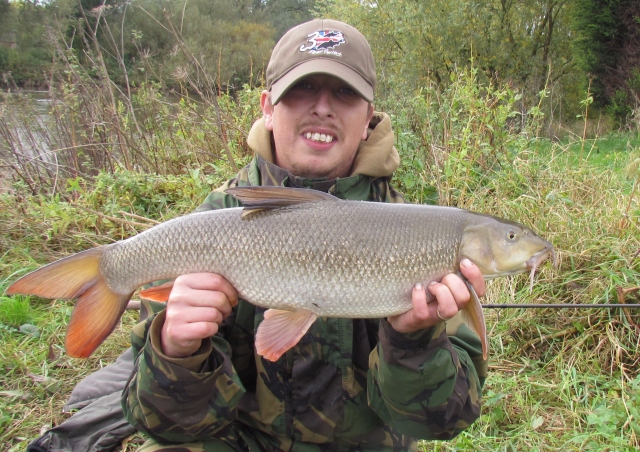
A 7lbs 10oz barbel was very welcome in near gale conditions!
I stayed on for a further hour with no more bites, and with the weather worsening as it then began to rain I decided to call it a day.
I decided that I would wait until the flood subsided somewhat to try again as not only did the rain not stop for the next few days, it also made fishing dangerous. Don’t get me wrong fishing can be fantastic on a flooded river, but I got the feeling that because the rain that fell was not exactly warm it was having an adverse effect on the fish, ultimately shocking them into a comatosed state.
After somewhat of a ‘lull’ in the weather, the water had dropped significantly for me to try again. It was a little warmer evening too, with a trend leaning towards a rise in temperature over the last few days, with a good barometric pressure of 1010 also.
I decided on a more upstream peg as I felt the fish could be more interested in looking for food, moving upsteam as they do so.
I chose to put our new bait, ‘The Plum’ through its paces, using a 16mm on an hair-rig. It was a quiet evening which made a change of the cold Northerly winds of recently. However the river was still carrying around 3ft of extra water which made the flow considerably quicker with the emphasis on bigger weights to hold bottom. Unfortunately the biggest, 5oz would not be enough to hold bottom so I took some the strap lead off one of the feeders and added it to the existing 5oz making it around 7oz which I felt was more than ample enough to hold in the flow.
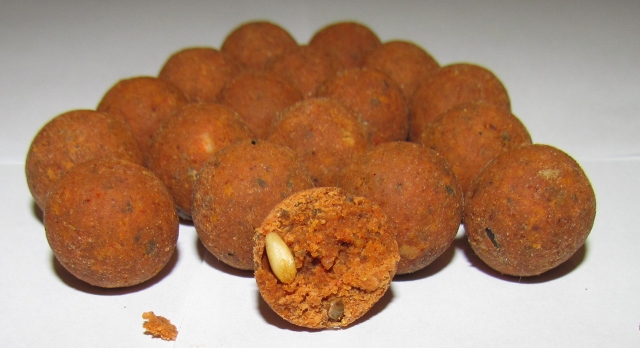
‘The Plum’
I settled into my swim and casted out, where I was quickly able to establish that the weight was indeed enough. It didn’t take long before there was a ‘jab’ on the tip, signifying something was taking a little interest in my hook bait.
Several minutes passed as I turned away for a second for me to look back around and see my rod hurtling down the bank (was on top of the bank due to high water), thinking a barbel was on and I was about to lose my rod, despite having the clutch loosely set I quickly dived down the bank after it which resulted in me slipping and getting a little wet for my troubles. However I managed to grab the rod, and after managing to clamber out of the water and onto some sort of dry bank I lifted the rod where I was met with a plucky resistance which told me all I needed to know, a chub!
I quickly managed to establish control and a plucky 3 pounder was in the net, not a bad start considering I had only been fishing for around 10 minutes or so.
I quickly re-baited and put the feeder right on the money again, it’s important to build up a swim slowly and casting to the same sort of area (no bigger than a bathtub) will do this. After waiting 45 minutes or so without a sign I quickly reeled in and tried again. Again I waited…
After 30 minutes, the rod tip sprung into life as it gave a series of twitches which I struck and immediately felt something that was at least pulling back a bit more. Quickly engaging the anti-reverse the fish began to make a run, at that point knowing it was a barbel. My stepped up gear of using a carp rod (due to the flow) instead of my normal barbel rods began to show on the fish as it was quickly tiring against the 3lb test curve rod and after a few minutes it was mine.
A fish of 8lbs 2oz wasn’t bad considering the lengthy cold spells we have been experiencing lately.
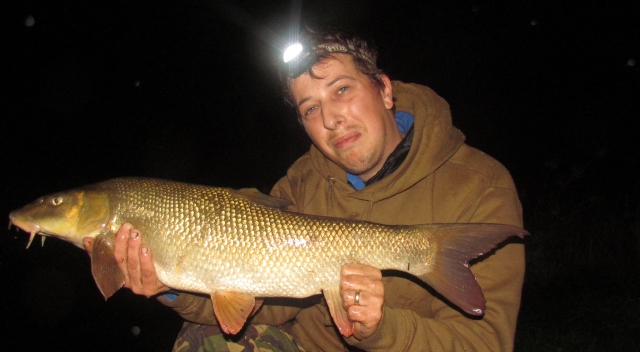
An 8lbs 2oz barbel was very welcome.
The fact this fish came relatively early in the session I felt more was on the cards, alas it did not materialise and despite moving I didn’t have another bite.
The next session was a bit colder with the odd gusts of wind which wasn’t pleasant. I began with a two rod pronged attack and had no action until 11Pm where my Dubby boilie was nailed on my upstream rod, where it inevitably sprang back which it does when fishing upstream from the large bow formed in the line. I didn’t take long to gain control and a nice 8lbs barbel was in my net. The photo was not great, partly due to me being cold and not holding the fish right, and secondly sporting a Russian head garment (never mind it kept me warm).
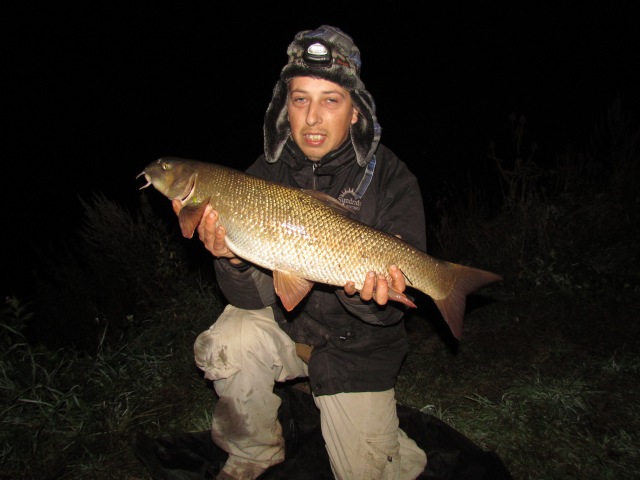
An 8lbs barbel saved a blank!
After this nothing else was forthcoming, forcing me to retire and make the drive home and the comfort of my bed.
The rest of the week that followed resulted in rain, wind and more rain which brought levels back up, which made matters worse as again it was from a cold direction making the river even colder quicker.
Unperturbed I did try to make best out of a bad situation by fishing downstream where I had caught my fish previously in the slacker area.
Fishing in the ‘crease’ for a session or two produced no bites or any touches, the fish were obviously not feeding, the colder weather had obviously put them off.
I decided that I would wait until things warmed up a bit, but for now my barbel fishing came to a shuddering stop. Sometimes, especially when during or nearing winter it will pay off to only venture out when the trend is right, when the pressure is right or when the levels of the river subside. By again being a cold rain it doesn’t do much for the fish to inspire them to feed.
People will argue that with a strong flow, extra water and extra colour, barbel need to move, therefore have to feed to maintain their weight. I believe this well to be the case during spates of higher river conditions when that extra water is from the West or South, but not when those rains are colder than that of the river initially. I am not an expert of course but I believe it’s quite easy for a barbel to sit behind a raft of rubbish, or inside a bend of the river being protected and unmoved from the flow, just deciding that they do not wish to feed.
Big river floods do not guarantee barbel, they can certainly help but you must consider the variables from where that rain has come from. If flood barbel fishing has taught me anything it’s to not believe that barbel are easier to catch exclusively regardless of where that extra water has come from. In my opinion this is not the case, quite simply it makes tracking down barbel a bit easier, but you can’t make them feed. What’s that old saying? “You can lead a horse to water, but you can’t make it drink”.
Quite simply in my opinion fishing a flooded river becomes easier to catch your quarry when you not only know where they’re holding up but when you know that the extra water is warm. This could be from the South or West, and not from an Easterly or Northerly direction.
Too often I hear people describe a river looking ‘spot on’ for barbel, it can of course but variables in weather and the trend of a rising and falling pressure have a determining factor in your barbel fishing.
The decision not to venture out and fish whilst these conditions prevailed was most probably a good one, although I will never completely know for sure.
In the next part I am back on the double trail where I will complete this series as I explain my limited time fishing throughout the winter and compiling the whole winter as one article to get it finished and to get ready for the new season blogs.
I will targeting the tench, bream and carp during the close season and hope to write a blog on this and the the types of methods I use to target these species on a lake in Nottingham.
The next part will be available soon, until then tight lines.
Richard

